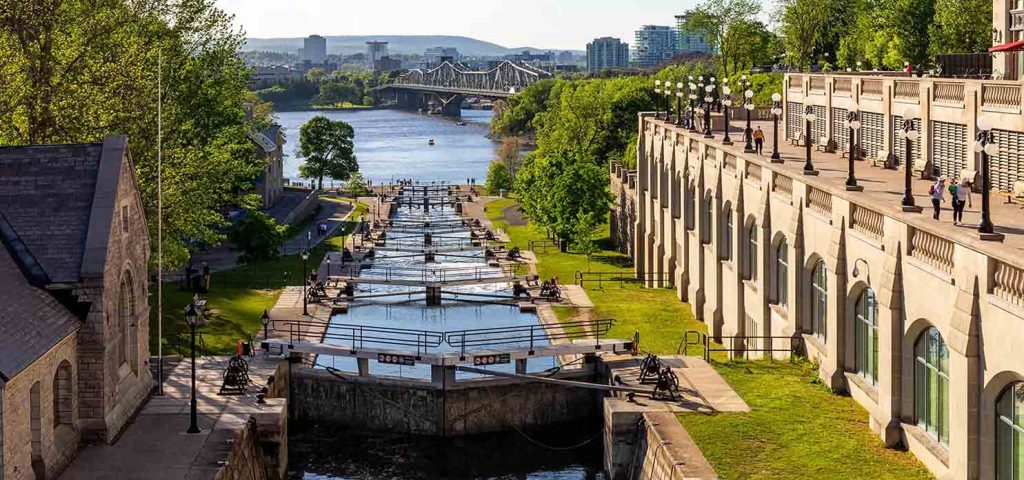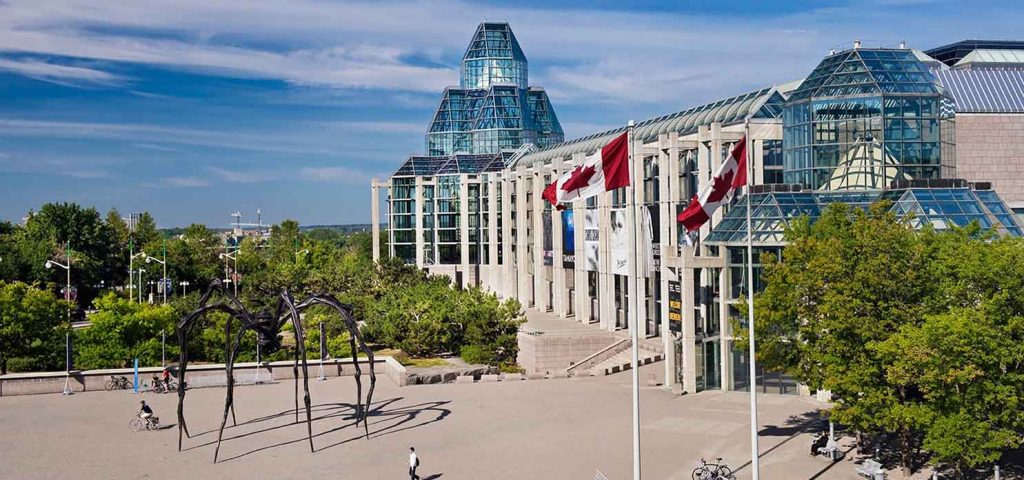Ottawa, the capital of Canada, may not be as bustling or glamorous as Toronto or Vancouver, but its unique charm and profound cultural heritage offer every visitor a distinctive experience. Walking through the streets of this city, I can always feel the interplay of history and modernity that this land embodies. This time, I decided to explore Ottawa through five landmark attractions, taking you into the heart of the city to experience its unique atmosphere and rich cultural heritage.
1. Parliament Hill: The Political Heart of Canada
Whether it’s your first visit to Ottawa or a return trip, Parliament Hill, located in the city’s heart, is always an unmissable first stop. As the symbol of Canadian politics, Parliament Hill is not just the center of government but also a site steeped in history. The architecture here is grand, with Western-style designs blending beautifully with elegant gardens, radiating a sense of solemnity. The Gothic Revival style of the buildings, with their intricate carvings, copper rooftops, and pointed arches, reveals a strong British influence, while the surrounding landscaping offers peaceful green spaces for both tourists and locals to enjoy.
Standing in front of the Parliament Buildings for the first time, I was struck by the impressive architecture. The soaring Peace Tower, which rises over 90 meters high, serves as the centerpiece and a poignant symbol of Canada’s commitment to peace and remembrance. The symmetrical layout of the East and West Blocks, coupled with the rich detailing of the façades, tells stories of the country’s past. Especially during the summer, tourists gather here to watch the ceremonial Changing of the Guard and the flag-raising ceremony, both of which are colorful displays of tradition and pride. Inside the Parliament Buildings, the debates in the Senate and House of Commons bring Canada’s political system to life, showcasing the vitality and order of the country’s democracy in action.
If you visit in the summer, don’t miss the free guided tours of Parliament Hill. Through these tours, I gained not only a deeper understanding of Canada’s political history but also insights into the country’s constitutional system. Guides often share lesser-known anecdotes, such as the rebuilding of the Centre Block after a devastating fire in 1916, or the symbolism behind the artwork within the Library of Parliament. After visiting Parliament Hill, I often find myself reflecting on how this steady land has not only been a symbol of power but also embodies the deep democratic traditions and political wisdom of Canadians. It’s a place that not only witnesses political decisions but also preserves the nation’s spirit and historical legacy.
2. Rideau Canal: A Waterway Through History
Ottawa’s Rideau Canal is one of the city’s most iconic natural landmarks, steeped in a long history. As a UNESCO World Heritage site, the canal was once a vital part of Canada’s transportation network, originally constructed for military purposes in the 19th century. Today, it is a cultural and recreational symbol of Ottawa, weaving through the heart of the city like a shimmering ribbon. Whenever I stand by the Rideau Canal, watching its winding waters, I often think about its past glory and the historical changes it has undergone. The canal stretches for over 200 kilometers, connecting Ottawa to Kingston, and passes through numerous locks and picturesque towns along the way.
In the winter, the Rideau Canal transforms into the world’s longest natural ice skating rink, attracting thousands of visitors who come to skate. Every winter, groups of ice skaters don their skates and glide freely along the canal, experiencing the rush of cold air and the thrill of the sport. It becomes not just a skating trail but a living winter festival, with pop-up kiosks selling maple taffy, poutine, and the famous BeaverTails pastries. One memorable winter afternoon, I sat in a small café by the canal, sipping hot chocolate while watching the snowflakes fall and the skaters glide by—a peaceful and heartwarming moment that I’ll never forget.

In the summer, the Rideau Canal becomes a haven for boaters, joggers, and cyclists. Riding a bike or boating along the canal offers a chance to take in the city’s beautiful scenery, from the verdant green spaces of Confederation Park to the charming old stone bridges that span the water. Canoes and kayaks silently glide past heritage buildings and willow-lined banks, while the nearby bike paths buzz with activity. Whether it’s the historic buildings along the canal or the lush parks nearby, it’s impossible not to slow down and savor the view. The Rideau Canal in any season offers a unique way to engage with Ottawa’s landscape and history, reminding visitors of the city’s seamless blend of nature and urban life.
3. Canadian Museum of History: Unveiling the Past of Canada
The Canadian Museum of History is the perfect place to delve deeply into the country’s rich and complex past. The museum’s architecture itself is an impressive work of art, with an exterior that resembles an Arctic iceberg—symbolizing Canada’s northern geography and deep historical roots. As I entered the soaring Grand Hall with its panoramic view of the Ottawa River and Gatineau Hills, I was instantly immersed in an atmosphere of reflection and discovery. Inside, the richness of the exhibits and the vivid, thoughtfully curated displays held my attention for hours. From the diverse cultures of Indigenous peoples to the arrival of European settlers, and from Canada’s journey through colonization to its confederation and emergence as a modern, multicultural nation, every room seemed to tell a vital chapter of the national story.
What left a particularly lasting impression on me were the exhibits detailing the early history of the country. Artifacts, dioramas, archival photographs, and immersive multimedia installations brought history to life—transporting me into different eras. I could almost hear the sounds of Indigenous languages, feel the tension of colonial struggles, and witness the evolution of Canadian identity. Additionally, the museum offers a variety of interactive experiences, such as touch-screen timelines, life-size reconstructions, and hands-on discovery rooms, which are particularly engaging for children and family visitors. The thoughtful presentation helps visitors of all ages build a deeper connection with Canada’s multifaceted past.
4. ByWard Market: The Pulse of Ottawa
ByWard Market is undeniably one of the most vibrant and culturally rich areas in Ottawa. Located just a short walk from Parliament Hill, it serves as the beating heart of the city’s social life. No matter the season, the market buzzes with activity—from early-morning shoppers picking up fresh produce to evening crowds enjoying drinks and music. With its blend of outdoor stalls, specialty boutiques, gourmet food vendors, and street performers, the area exudes a dynamic and welcoming energy. Every time I visit, I discover a new vendor, a unique artisan product, or an unexpected flavor I’ve never tried before.
The local food scene at ByWard Market is especially captivating. It’s impossible to walk through without being tempted by the mouthwatering smells wafting from food stalls. Whether it’s the iconic Beavertails—a warm, fried pastry topped with cinnamon sugar and other sweet toppings—or a hearty serving of Poutine loaded with cheese curds and rich gravy, these comfort foods are quintessentially Canadian. During colder months, these treats feel even more indulgent and comforting. In addition to these, you’ll find stalls offering maple syrup-infused snacks, international street foods, and fresh-baked bread and pastries.
Surrounding the market are charming cafés, quirky bars, and live music venues that keep the area alive long into the night. Whether you’re sipping a craft cocktail, chatting over espresso, or listening to a jazz band play outside, the ambiance here is unforgettable. It’s more than just a place to shop or eat—it’s a living, breathing part of Ottawa’s cultural soul.
5. National Gallery of Canada: A Meeting Place for Art and Creativity

As one of the most prestigious art institutions in the country, the National Gallery of Canada is a sanctuary for lovers of beauty, creativity, and cultural reflection. Located near the banks of the Ottawa River and identifiable by its modern architecture and prominent glass tower, the museum stands as a testament to Canada’s dedication to preserving and celebrating the visual arts. As I stepped inside, I was immediately struck by the sense of calm and inspiration that permeated the grand, light-filled spaces. Each room led me deeper into a visual dialogue between cultures, time periods, and artistic movements.
The Indigenous Art section left a profound impression on me. It features an extensive collection of art that spans centuries—from ancient ceremonial objects and traditional masks to contemporary installations and paintings. These works not only reflect the resilience and traditions of Indigenous communities but also offer powerful commentary on identity, colonialism, and cultural continuity. Many pieces blend traditional symbolism with modern media, resulting in visually striking and emotionally resonant expressions of heritage.
Ottawa is a city rich in history and cultural depth. Visiting these landmark attractions provides an opportunity to better understand Canadian culture. From the political heart of Parliament Hill to the lively ByWard Market, from the history-filled Canadian Museum of History to the artistic creativity on display at the National Gallery, each of these places has deepened my appreciation for this country. Every street and building in Ottawa exudes a quiet yet profound charm, waiting for visitors to discover and savor.
My first visit to Ottawa has brought not just visual impressions but also emotional resonance. Behind each landmark lies a unique story and history, worthy of our reflection and appreciation.
